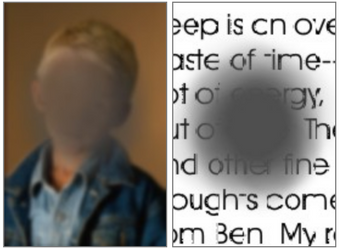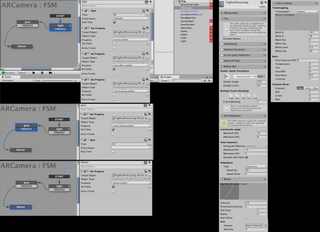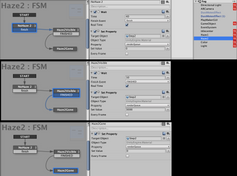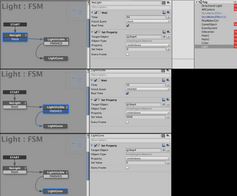StarAR
A Simulation of the Progression of Stargardt Disease
by Ariana Ehuan
Stargardt disease is the most common cause of macular degeneration in adolescents. This application is intended to give people with minimal experience with this disease a general feel for its progression and symptoms. The goal is education for both members of the public and family members of those afflicted.

The aim of this project is to simulate the experience of having Stargardt disease. Stargardt is the most common cause of macular degeneration in adolescents. It starts by causing slowly decreasing central vision, which looks like hazy spots. This process may speed up and level off, rarely resulting in total blindness. Color perception may also be decreased over the progression of the disease, as well as light sensitivity. The content of this project with be simulating this disease progression in a qualitative way using Unity, augmented reality, and particle effects. As this will be an educational piece for members of the public who may know nothing about this disease, I plan to achieve epistemic curiosity through desire to better understand the reality behind their experience. Viewers will want to better understand the disease and have more empathy to sufferers. This curiosity will be motivated by the novel experience of actually “having” the symptoms of the disease through an augmented reality cell phone application. There also may be an element of surprise if the viewer/wearer is not expecting their vision to be affected in the way that it is.
My goal is to become a scientific/medical animator and so I have been trying to explore this concentration in my graduate work. My original idea for this project was to create a wearable technology with visual, auditory, and tactile elements to explore a kidney disease that effects all of those senses. However, time and technology constraints meant that I needed to downsize my project scope. As a result, I looked into interesting eye conditions, as visual is the medium I am most comfortable in. Stargadt disease caught my attention because it is not uncommon, but not well-known and it effects children, which makes it especially important to draw awareness to. My audience would be primarily parents, although there is potential use for occupational therapists to better help their patients. This app is intended as a very usable, accessible app so that parents could use it at home to better empathize with their children and rearrange their homes as needed.
Unity was used with Particle Pack, Playmaker, and AR Kit to create my app. Particle Pack is the free particle plugin for Unity. It had a few prefabricated particle systems, and I was able to tweak one to create a foggy effect that I felt was a good metaphor for the hazy spots caused by Stargardt disease. I then used Playmaker to animate my scene’s post-processing effects, as those effects cannot be directly keyframed themselves. Motion blur and eye adaption were kept on for the whole scene, while color grading and bloom were keyed to turn on as the associated text explained the related symptoms.
Unity Steps:
Decreasing central vision with slow progression, acceleration, and then leveling off
-
Particle Pack was used for the initial haze. It started at a lowered opacity and a white tone, before rising in opacity.
-
Then fog density in post-processing was keyed in to create an acceleration of vision loss. A grey tone was used to create depth against the particles’ white tone.
-
Finally, both were kept constant after they had risen to their desired levels.
-
This mimics a slow, fast, then equalized progression while still straddling the line between realistic and artistic.
Color perception may also be decreased over the progression of the disease
-
I used color grading to reduce saturation through the camera after the fog and particles had stabilized.
-
Saturation was not completely zeroed out, as color perception loss is a progression, so I wanted it to feel in-progress.
Light sensitivity may increase
-
Bloom was used to overdo the light in the scene after a set amount of time to make light painful.
-
Originally, bloom occurred before color grading, but I realized that bloom was more pronounced when desaturation of the scene brought more colors close to white.
Text explanations also are keyframed to appear and disappear to explain each step.
AR Kit was used to send the simulation to my iPad, so that I could test the app in the real world.
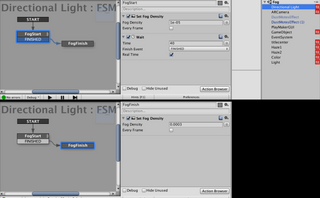
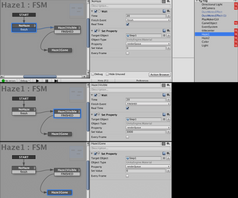
In the app, an error occurs where both the special effects and the titles have to be tracked down, despite being parented to the camera in Unity. They also refuse to exist on the same side of the camera/viewer. Finally, the text is ridiculously oversized, despite being a fraction of a nit high in Unity. However, I stand by my idea as a novel simulation of a lesser-known disease. It has potential to be a design tool for designer who is thinking about how an environment needs to change to accommodate someone with Stargadt disease. Color, contrast, light, shape, and form are beginning to come into play in my app, and the errors are solvable as I continue to move forward.

